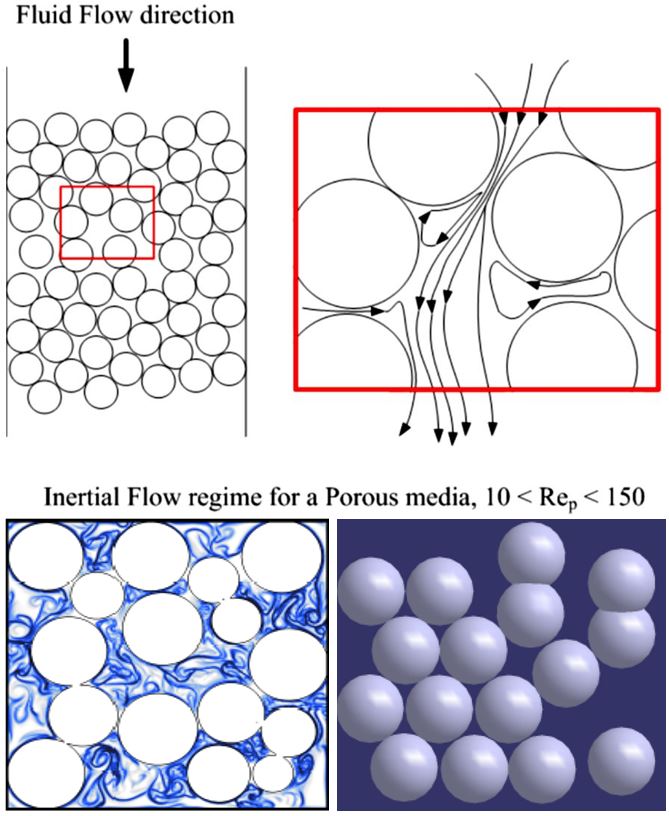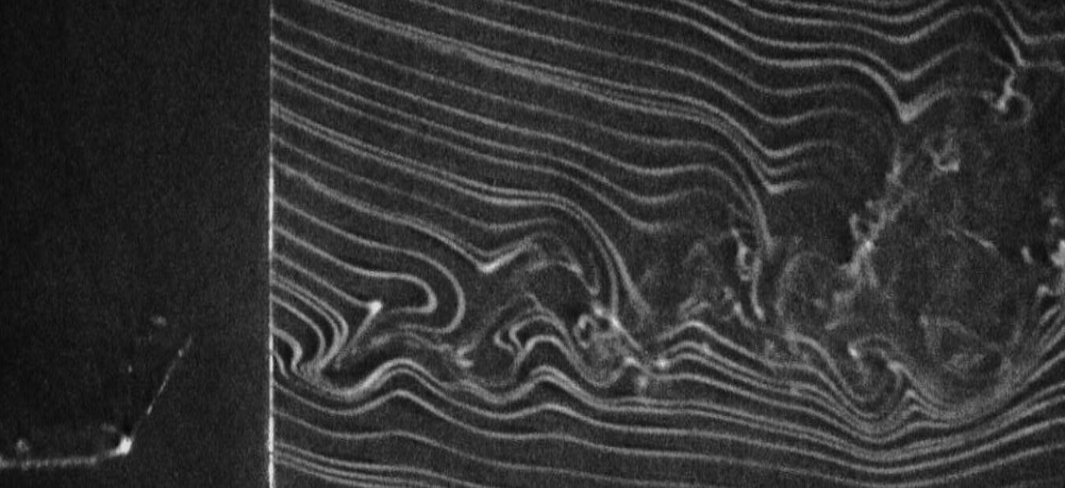The research topics currently under investigation are all areas that involve uncovering basic fundamental fluid mechanics based on noninvasive experimental methods. Our work uses state-of-the-art methods to measure detailed, time resolved flow fields, that are then analyzed to determine kinematic and dynamic flow events useful for a variety of engineering applications. Below is a brief description for each area, links provide more detailed information on our outcomes.
Transient influx in multiphase flow (partially funded by DOE NETL)
Due to geological reasons, there are randomly spread subsurface reservoirs with different pressurized fluids in them. These reservoirs are not easily detectable. Hence, when drilling a well one can penetrate such reservoir. Highly pressurized fluid mixes with the drilling fluid and a multiphase flow occurs in the wellbore annulus. Being highly pressurized, such flow inevitably creates hazardous conditions for drilling personal and environment. It is important to detect influxes into wellbores as early as possible in order to take urgent preventive measures. Therefore, real time monitoring of downhole flow conditions is necessary.
Different models exist for multiphase flow description. Excessive fidelity of one group of them doesn’t allow for real time modeling due to large computational requirements. Noticeable inaccuracy of the other group of models doesn’t allow for necessary flow characterization. Hence, the choice was made to employ drift-flux model to simulate an influx into a multiphase flow. Drift-flux model allows for quick flow simulation giving a reasonable accuracy.
Today, we have been able to simulate a mock transient gas influx into a single phase liquid flow. The form of drift-flux model we used is written for bubbly gas-liquid flow. We used time dependent boundary conditions to create a signature of influx. The results are presented on the figures – for a 500 m vertical pipe and 1000 seconds of simulation.
Drift-flux model contains three parameters which are highly dependent on flow conditions. Hence, the problems which have been solved with the help of drift-flux model are highly specific and applicable for narrow fields. We are aiming to describe a sufficiently wide range of possible multiphase flows with drift-flux model. For this purpose a fundamental research on drift-flux model parameters and mathematical behavior during an influx is necessary.
We plan to conduct a series of experiments as well as simulations on wide variety of flow conditions. Then we shall use multivariate analysis technics and, if necessary, machine learning algorithms to come up with reliable expressions for drift-flux model.
Transition to turbulence in porous media (NSF)

Flow in porous media is a complex combination of geometric and flow constraints that are difficult in general to both analyze and measure. There are a wide range of applications from engineering systems, such as packed beds used in chemical processing, power reactors, advanced heat exchangers, all the way to natural flows in the envirment such as water, natural gas and oil. We are interested in learning about the intricate characteristics of how turbulence forms and contributes to the transport properties of these flows. The complex geometry, wide range of length scales, and imposed time scales lead to very unique dispersion characteristics that govern how flows occur in both randomly arranged and geometrically designed porous media.
Our lab is equipped with a time resolved particle image velocimetry (TR-PIV) system to measure both two and three velocity components. In order to do this properly we have applied refractive index matching of the fluid, porous structure and containment walls to minimize distortion. We have been able to obtain highly resolved (in space and time) accurate velocity fields from which we have analyzed dispersion and transport properties at very high pore Reynolds numbers. We are continuing this work to obtain three component turbulence data that can be used to extend turbulence theory and modeling into these complex flows for randomly distributed porous flows.
Kinetic Aerodynamics for Energy Harvesting and Propulsion (NSF)

Flapping foil energy harvesters are a novel fluid energy harvester design that utilize a flapping motion similar to that seen in bird or insect flight. These unsteady turbines have advantages over conventional rotating turbines including reduced blade tip speeds as well as being more economical for sites with restrictive geometry such as shallow river beds. Unlike conventional turbines where the flow is attached, these unsteady flapping turbines experience a phenomenon known as dynamic stall in which significant flow separation occurs over the blade leading to a temporary increase in the aerodynamic force and subsequent power generated. Our lab focuses on the fundamental physics of the fluid flow via experimental wind tunnel testing that includes Particle Image Velocimetry (PIV) as well as aerodynamic force measurements; in addition, our lab also works on low order aerodynamic models such as discrete vortex methods for design purposes.
Convective Thermal Management (ONR, Intel, HP)

The need to provide cooling to high power electronics is a continuing pursuit with the goal of providing faster and more powerful electronic systems. New challenges also include the ability to provide transient cooling methods that are spatially controlled (that is temporal-spatial thermal control). Our approach to this problem is designing new cooling technologies based on convective boiling where the boiling process is controlled/enhanced using in-situ vapor extraction. The idea is to remove vapor during the boiling process from the heat source by using a hydrophobic membrane (allowing vapor passage while retaining the liquid phase).In this way local dry out can be prevented, there is also control of the local void fraction and the resultant local heat transfer coefficient can be enhanced.
This cooling approach relies on vapor extraction within a convecting or pool boiling environment. In either situation the efficiency of bubble extraction is critical. The bubble-membrane interaction dynamics plays a role in the extraction process, and at this point is poorly understood. Our research is currently studying the interaction of bubbles with hydrophobic membranes during vapor extraction to better design the cooling process. The goal is to provide a physics-based model coupled with detailed experimental studies of the extraction process to gain an understanding of the spatial-temporal characteristics needed for cooling module design. We have applied this technique to a variety of microchannel flow geometries, including fractal-like flow channels.
Advanced power cycle development (Local Industry)
In order to sustain our environment while maintaining a high standard of living and productivity it is necessary to vastly improve our power generation capabilities. One important area, that consumes a huge amount of resources, are internal combustion engines. These engines are a mainstay in our society but may come with a huge cost to our environment and natural resources. In order to assure that our near term futureis sustainable vastly improved efficiencies coupled with lower polluting emissions are needed.
This research project aims to approach the problems associated with fossil fuel utilization (oil, gasoline, natural gas) by developing modifications to typical thermodynamic cycles, as well as their implementation, for both stationary and vehicular power sources. High overall efficiencies are shown to be achievable while lowering both soot and NOx emissions using a combination of improved combustion optimization, cycle thermal loss reduction, and high effective compression ratios.